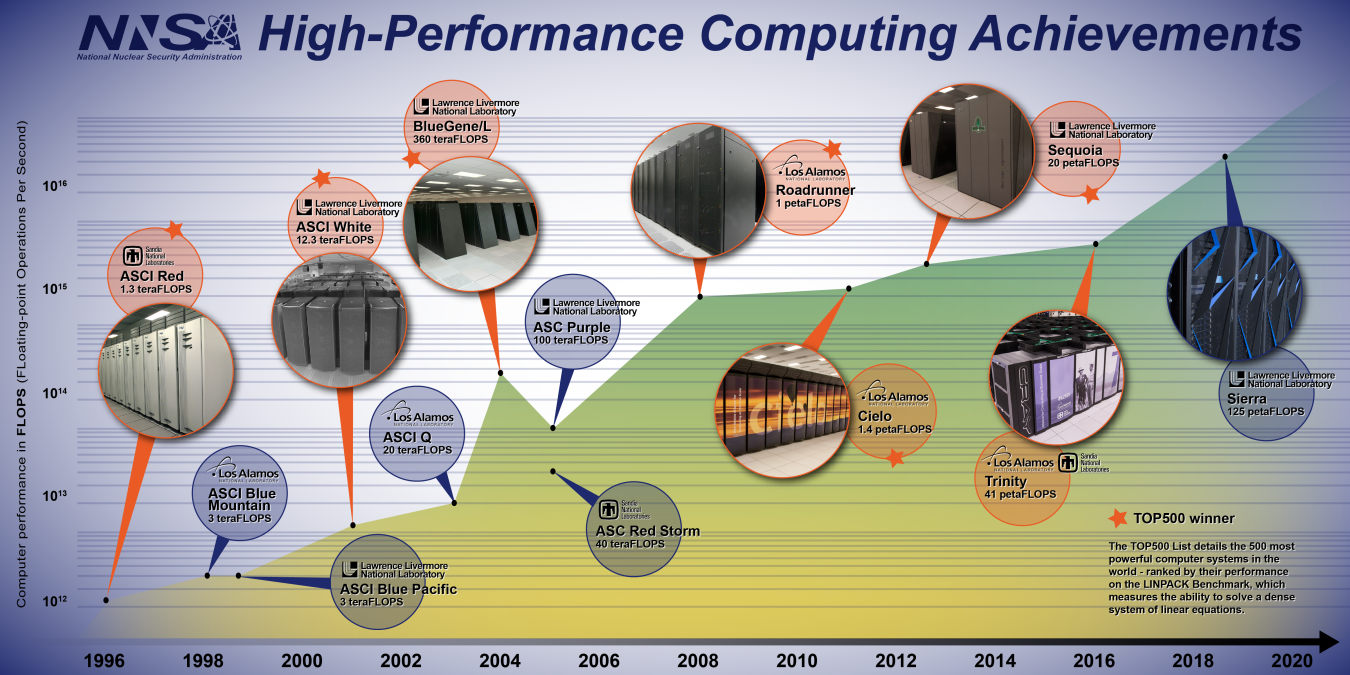
ASCI Red was located at Sandia National Laboratories and built by Intel. Red broke records as the world’s first teraFLOPS supercomputer, which means that it could perform 1 trillion floating point operations per second. In addition to its unprecedented speed, the system was acknowledged for its high rate of reliability.
ASCI Blue Mountain was located at Los Alamos National Laboratory and built by SGI. With a speed of 3 teraFLOPS, one of this system’s major contributions to the NNSA mission was its support to the W88 Pit Rebuild Program, for which it provided simulations to develop the manufacturing process.
ASCI Blue Pacific was located at Lawrence Livermore National Laboratory and built by IBM. With a speed of 3 teraFLOPS, Blue Pacific enabled the first 3D primary simulation and allowed for testing of increasingly complex design codes.
ASCI White was located at Lawrence Livermore and built by IBM as well. White was the first routinely shared tri-lab resource, with a speed of 12 teraFLOPS. From November 2000-2001, it held the No. 1 spot on the TOP500 list (a biannual ranking of the world’s 500 most powerful supercomputers). Contributions include enabling the first 3D full-device simulation as well as the first 3D assessment simulation.
ASCI Q was located at Los Alamos and built by Compaq, with a speed of 20 teraFLOPS. It enabled the first million-atom simulation in biology for the molecular mechanism of the genetic code, defining a new “state-of-the art” in biomolecular simulation.
BlueGene/L was located at Lawrence Livermore and built by IBM. As the first low-power “green” supercomputer, BlueGene achieved a speed of 360 teraFLOPS and extreme peak performance with very low power consumption. It held the No. 1 TOP500 spot from November 2004 to 2007. The system was used to resolve issues during plutonium aging assessments and enabled multi-scale model development. It also aided in refinement of the design of the National Ignition Facility.
ASC Red Storm was located at Sandia and built by Cray. It had a speed of 40 teraFLOPS, and was used to support DoD’s Operation Burnt Frost to shoot down an errant satellite traveling at 17,000 miles per hour, 153 miles above the earth.
ASC Purple was located at Lawrence Livermore and built by IBM. It achieved a speed of 100 teraFLOPS, and enabled the routine production use of a complex 3D integrated weapons code for programmatically relevant simulation at scale.
Roadrunner was located at Los Alamos and built by IBM. This was the first supercomputer to break the once-elusive petaFLOP barrier, meaning that Roadrunner was capable of one quadrillion, or a thousand trillion, floating point operations per second. It helped close a difficult, long-standing gap in understanding of energy flow in a weapon and its relation to weapon yield. A power-efficient hybrid computer, Roadrunner held the No. 1 spot on TOP500 from June 2008-2009, as well as the No. 3 spot on the Green500 list of energy-efficient supercomputers.
Cielo was located at Los Alamos and was built by Cray. With a speed of 1.4 petaFLOPS, Cielo was the first supercomputer to run routine 3-D weapons simulations. It was used for engineering design and assessment in support of critical B61-12 Life Extension Program (LEP) deliverables: for example, captive carry simulations of the F-35 informed design decisions.
Sequoia is located at Lawrence Livermore and was built by IBM. This supercomputer, which has a speed of 20 petaFLOPS, is focused on strengthening the foundations of predictive simulation through complex simulations called uncertainty quantification (UQ) studies, providing highly resolved 2D UQ and entry-level 3D UQ. Sequoia is used for weapons science calculations necessary to build more accurate physical models. The system held the No. 1 spot on the TOP500 list in June 2012.
Trinity is located at Los Alamos and was built by Cray. With a peak performance of 41.5 petaFLOPS, it presents an 8x improvement over Cielo in fidelity, physics, and performance capabilities. As the most recent supercomputing addition to come fully online, Trinity has provided enhanced computational capability and greater exactness for geometry and physics simulations.
Sierra is being built at Lawrence Livermore by IBM and expected to join the lineup in fiscal year 2018. It represents a giant leap forward in power, with a projected performance level of 125 petaFLOPS. The installation is a collaborative effort between Oak Ridge, Argonne, and Livermore.

